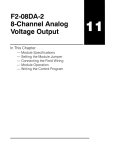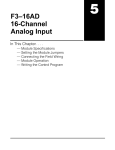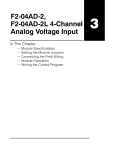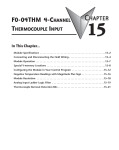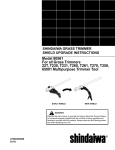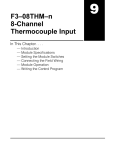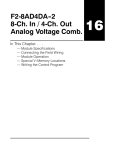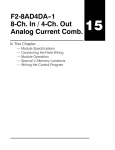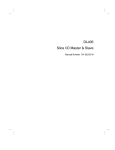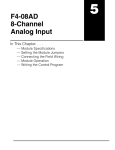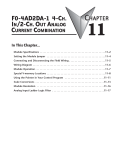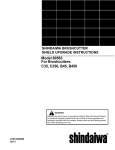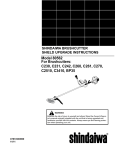Download Chapter 8 - AutomationDirect
Transcript
F3–04DAS
4-Channel Isolated
Analog Output
In This Chapter. . . .
18
Ċ Module Specifications
Ċ Setting the Module Jumpers
Ċ Connecting the Field Wiring
Ċ Module Operation
Ċ Writing the Control Program (DL340/DL350)
Ċ Writing the Control Program (DL350)
8–2
F3–04DAS 4-Channel Isolated Analog Output
Module Specifications
F3–04DAS
4 Ch. Isolated Analog Out.
The following table provides the specifications for the F3–04DAS Analog Output
Module. Review these specifications to make sure the module meets your
application requirements.
Number of Channels
4
Output Ranges
"5V, "10V, 0–5V, 0–10V, 1–5V,
0–20 mA, 4–20 mA
Resolution
12 bit (1 in 4096)
Output Type
Isolated, 750 VDC channel-to-channel
750 VDC channel-to-logic
Output Current
"5 mA, voltage output
Short-circuit Current
"20 mA typical, voltage output
Capacitive Load Drive
0.1mF typical, voltage output
Load Impedance
470W maximum, current output
2KW minimum, voltage output
Isolation Mode Rejection
140 dB at 60Hz
Linearity Error
"1 count ("0.03% maximum)
Calibration Error
"0.15% typical, "0.75% maximum of span
"10 ppm / _C maximum of full scale
Calibrated Offset Error
"1 count maximum, current output
"5 mV typical, "50 mV max., voltage output
"0.2 mV typical / _C
Conversion Time
30mS maximum, 1 channel/scan
Power Budget Requirement
154 mA @9V, 145 mA @ 24V (maximum)
External Power Supply
None required
Operating Temperature
32° to 140° F (0° to 60° C)
Storage Temperature
–4° to 158° F (–20° to 70° C)
Relative Humidity
5 to 95% (non-condensing)
Environmental air
No corrosive gases permitted
Vibration
MIL STD 810C 514.2
Shock
MIL STD 810C 516.2
Noise Immunity
NEMA ICS3–304
8–3
F3–04DAS 4-Channel Isolated Analog Output
Analog Output
Configuration
Requirements
The F3–04DAS Analog Output appears as a 16-point module. The module can be
installed in any slot configured for 16 points, but should not be installed in Slot 3 of
any DL305 base. See the DL305 User Manual for details on using 16 point modules
in DL305 systems. The limitation on the number of analog modules are:
S For local and expansion systems, the available power budget and
16-point module usage are the limiting factors.
WARNING: You should not install this module in Slot 3 of any DL305 base. The
module has traces on the edge card connector that may become damaged if
the module is repeatedly installed and removed. The solder mask that
protects the traces may be scraped off, which may cause a short circuit on the
I/O bus. The short circuit can lead to unpredictable system operation or cause
damage to the CPU or power supply.
2
1
0
C
P DL305
U
6
5
4
3
2
1
0
C
P DL305
U
10
or
7
6
5
4
3
2
1
70
0
C
P DL305
U
F3–04DAS
4 Ch. Isolated Analog Out.
3
8–4
F3–04DAS 4-Channel Isolated Analog Output
Setting the Module Jumpers
Jumper Locations
The module is set at the factory for a 0–10V signal on all four channels. If this is
acceptable you do not have to change any of the jumpers.
If you examine the top board on the module you will notice four sets of jumpers. The
jumpers are assigned to the channels as follows.
S Channel 1 — Jumper JP4
S Channel 2 — Jumper JP3
S Channel 3 — Jumper JP2
S Channel 4 — Jumper JP1
F3–04DAS
4 Ch. Isolated Analog Out.
NOTE: At first glance it might appear we have the channel / jumper assignments out
of order. Your eyes do not deceive you. Channel 1 is controlled by JP4.
Each channel also has a jumper located on the bottom board of the module. These
jumpers select a 1V (or 4mA) offset for each channel. Remove the jumper for any
range that requires an offset. These jumpers are assigned as expected. JP1 selects
an offset for channel 1, JP2 selects an offset for channel 2, etc.
The following diagram shows how the jumpers are assigned. It also shows the
factory settings.
Channel 1 Range
Channel 2 Ranges
J
P
3
1
1
Channel 3 Ranges
J
P
2
Channel 4 Ranges
1
1
JP1
J
P
4
Channel 1 Offset
J
P
1
Channel 2 Offset
JP2
Channel 3 Offset
JP3
Channel 4 Offset
JP4
8–5
F3–04DAS 4-Channel Isolated Analog Output
Selecting Input
Signal Ranges
The following tables show the jumper selections for the various ranges. (Only
channel 1 is used in the example, but all channels must be set.)
Bipolar Signal Range
Jumper Settings
–5 VDC to +5 VDC
Channel 1 (JP4)
Offset Jumper (JP1)
Channel 1 (JP4)
Offset Jumper (JP1)
1
–10 VDC to +10 VDC
1
Unipolar Signal Range
Jumper Settings
Channel 1 (JP4)
Offset Jumper (JP1)
Channel 1 (JP4)
Offset Jumper (JP1)
Channel 1 (JP4)
Offset Jumper (JP1)
1
0 VDC to +5 VDC
(0 to +20 mA)
1
0 VDC to +10 VDC
1
F3–04DAS
4 Ch. Isolated Analog Out.
4 to 20 mA
(1 VDC to 5 VDC)
8–6
F3–04DAS 4-Channel Isolated Analog Output
Special Output
Signal Ranges
The following tables show the jumper selections for some additional ranges that are
not normally found in many applications. Notice you can install or remove the offset
jumper to change the settings. (Only channel 1 is used in the example, but all
channels must be set.)
Signal Range
Offset Installed
Signal Range
Offset Removed
Jumper Settings
–10 VDC to +6 VDC –9 VDC to +7 VDC
Channel 1 (JP4)
1
–5 VDC to +3 VDC
–4 VDC to +4 VDC
Channel 1 (JP4)
F3–04DAS
4 Ch. Isolated Analog Out.
1
–2.5 VDC to
+2.5 VDC
–1.5 VDC to
+3.5 VDC
Channel 1 (JP4)
1
–2.5 VDC to
+1.5 VDC
–1.5 VDC to
+2.5 VDC
Channel 1 (JP4)
1
0 VDC to 8 VDC
1 VDC to 9 VDC
Channel 1 (JP4)
1
0 VDC to 4 VDC
1 VDC to 5 VDC
Channel 1 (JP4)
1
8–7
F3–04DAS 4-Channel Isolated Analog Output
Connecting the Field Wiring
Wiring Guidelines
Your company may have guidelines for wiring and cable installation. If so, you should
check those before you begin the installation. Here are some general things to
consider.
S Use the shortest wiring route whenever possible.
S Use shielded wiring and ground the shield at the module or the power
supply return (0V). Do not ground the shield at both the module and the
transducer.
S Don’t run the signal wiring next to large motors, high current switches, or
transformers. This may cause noise problems.
S Route the wiring through an approved cable housing to minimize the risk
of accidental damage. Check local and national codes to choose the
correct method for your application.
User Power Supply The F3–04DAS receives all power from the base. A separate power supply is not
required.
Requirements
Each channel can be wired independently for a voltage or current transducer.
S Current transducers must have an impedance less than 470 ohms.
S Voltage transducers must have an impedance greater than 2K ohms.
F3–04DAS
4 Ch. Isolated Analog Out.
Load
Requirements
8–8
F3–04DAS 4-Channel Isolated Analog Output
Removable
Connector
Wiring Diagram
The F3–04DAS module has a removable connector to make wiring easier. Simply
squeeze the top and bottom tabs and gently pull the connector from the module.
Note1: Shields should be connected to the respective channel’s
– V terminal of the module.
Note 2: Each isolated output channel may have either a voltage or
current load, but not both
ANALOG OUTPUT
F3–04DAS
Note 3: An external 0.31 Amp fast-acting fuse in series with the isolated
+I terminal (+15VDC) is recommended to protect against accidental
shorts to the –V terminal (15VDC common)
Note 4: Do not attempt to source more than 20mA from any one of the
four isolated +15VDC power supplies
Internal Module Wiring
See note
+I
CH1
Current
Output
0-470 ohm
+I
CH2
Current
Output
0-470ohm
+I
CH1
+V
CH1
–I
CH2
+V
–I
–V
CH3
CH3
Voltage
Output
2K ohm min
15VDC (20mA)
Isolated Power
–V
CH4
Current
Sink
–V
CH2
+V
–I
CH2
CH3
+V
–I
CH3
+I
CH4
–I
–V
–V
Voltage
Output
+V
CH1
–V
+V
+I
+V
–I
+I
–I
CH4
Voltage
Output
2K ohm min
CH1
+I
Current
Sink
–V
+I
F3–04DAS
4 Ch. Isolated Analog Out.
Voltage
Output
CH4
+V
–I
CH4
–V
15VDC (20mA)
Isolated Power
Internal wiring for CH2 & 3 is
similar to wiring shown above
Combining Voltage You may occasionally encounter transmitters that have a very unusual signal range.
Since each channel is isolated, you can “daisy chain” the channels to provide output
Outputs
voltage signals that are outside of the normal operating range. For example, you
could connect the first two channels to provide a voltage output from 0 to 20 VDC.
+V
User Load
2K ohm min
0–20V
CH1
0–10
–V
CH1 & 2
are configured
for 0–10V
+V
CH2
–V
0–10
8–9
F3–04DAS 4-Channel Isolated Analog Output
Combining Current You cannot connect the current outputs in series (like the voltage outputs) but you
can achieve unusual ranges with a few wiring and programming tricks. For example,
Outputs
let’s say an application requires a "20 mA range. By completing the following steps,
you could easily accommodate this requirement.
1. Configure channel 1 and channel 2 for 0–20mA.
2. Connect the +I of channel 1 to the –I of channel 2.
3. Connect the –I of channel 1 to the +I of channel 2.
4. Send 0 (digital value) to channel 2 while you send 0–4095 (digital value) to
channel 1. To reverse the power flow, send 0 to channel 1 while you send
the 0–4095 value to channel 2. (See the section on Writing the Control
Program for information on sending data values.)
WARNING: The isolated +15 VDC power supplies are rated at a maximum of 20
mA. Current ratings that exceed 20 mA will damage the module beyond repair.
For example, if you used the 0–10 VDC range for the example, the current
would approach 40 mA which would cause damage to the module.
+/– 20mA
CH1
0–20mA
–I
CH1 & 2
are configured
for 0–20mA
+I
CH2
–I
0–20mA
F3–04DAS
4 Ch. Isolated Analog Out.
+I
User Load
0–470 ohm
8–10
F3–04DAS 4-Channel Isolated Analog Output
Module Operation
Channel Scanning
Sequence
Before you begin writing the control program, it is important to take a few minutes to
understand how the module processes and represents the analog signals.
The F3–04DAS module can update one channel per CPU scan. Your RLL program
selects the channel to update, so you have complete flexibility in solving your
application requirements.
Scan
F3–04DAS
4 Ch. Isolated Analog Out.
I/O Update
Channel 1
Scan N
Execute Application Program
Channel 3
Scan N+1
Channel 1
Scan N+2
Channel 4
Scan N+3
Channel 2
Scan N+4
Calculate the data
Write data
8–11
F3–04DAS 4-Channel Isolated Analog Output
Understanding the You may recall the F3–04DAS module appears to the CPU as a 16-point module.
These 16 points provide:
I/O Assignments
S the digital representation of the analog signal.
S identification of the channel to receive the data.
Since all I/O points are automatically mapped into Register (R) memory, it is very
easy to determine the location of the data word that will be assigned to the module.
F3–04DAS
8pt
Relay
8pt
Output
8pt
Output
050
–
057
040
–
047
030
–
037
16pt
Input
4ch.
(Analog)
020
027
–
120
127
R 002, R012
010
017
–
110
117
16pt
Input
000
007
–
100
107
R 000, R010
1
1
7
R 001
LSB
MSB
1
1
0
LSB
0
1
0
0
1
7
Within these two word locations, the individual bits represent specific information
about the analog signal.
Channel Selection
Inputs
The last four points of the upper register
are used as outputs to tell the module
which channel to update. In our example,
when output 114 is on, channel 1 will be
updated. Here’s how the outputs are
assigned.
Output
Channels
114
1
115
2
116
3
117
4
R011
MSB
LSB
1 1 1 1 1 1 1 1
1 1 1 1 1 1 1 1
7 6 5 4 3 2 1 0
- channel selection inputs
F3–04DAS
4 Ch. Isolated Analog Out.
R 011
MSB
8–12
F3–04DAS 4-Channel Isolated Analog Output
Analog Data Bits
The remaining twelve bits represent the
analog data in binary format.
Bit
Value
Bit
Value
0 (LSB)
1
6
64
1
2
7
128
2
4
8
256
3
8
9
512
4
16
10
1024
5
32
11
2048
R011
R001
MSB
LSB
1 1 1 1 11 1 1
1 1 1 1 11 1 1
7 6 5 4 32 1 0
0 0 0 0 0 0 0 0
1 1 1 1 1 1 1 1
7 6 5 4 3 2 1 0
- data bits
Since the module has 12-bit resolution, the analog signal is converted into 4096
“pieces” ranging from 0 – 4095 (212). For example, with a 0 to 10V scale, a 0V signal
would be 0, and a 10V signal would be 4095. This is equivalent to a a binary value of
0000 0000 0000 to 1111 1111 1111, or 000 to FFF hexadecimal. The following
diagram shows how this relates to each signal range.
–10V – +10V
–5V – +5V
F3–04DAS
4 Ch. Isolated Analog Out.
+V
0V – 10V
0V – 5V
+V
1V – 5V
4 – 20mA
+5V
20mA
1V
4mA
0V
-V
0V
0
4095
0
4095
Each “piece” can also be expressed in
terms of the signal level by using the
equation shown. The following table
shows the smallest signal levels that will
possibly result in a change in the data
value for each signal range.
Range
0
4095
0
4095
Resolution + H * L
4095
H = high limit of the signal range
L = low limit of the signal range
Highest Signal
Lowest Signal
Smallest Change
–10 to +10V
+10V
–10V
4.88 mV
–5 to +5V
+5 V
–5V
2.44 mV
0 to 5V
5V
0V
1.22 mV
0 to 10V
10V
0V
2.44 mV
1 to 5V
5V
1V
0.98 mV
20mA
4mA
3.91 mA
4 to 20mA
Now that you understand how the module and CPU work together to gather and
store the information, you’re ready to write the control program.
8–13
F3–04DAS 4-Channel Isolated Analog Output
Writing the Control Program (DL330 / DL340)
Identifying the
Data Locations
As mentioned earlier, you can use the channel selection bits to determine which
channels will be updated. The following diagram shows the location for both the
channel selection bits and data bits.
F3–04DAS
8pt
Relay
8pt
Output
8pt
Output
050
–
057
040
–
047
030
–
037
16pt
Input
4ch.
(Analog)
020
027
–
120
127
010
017
–
110
117
R 002, R012
16pt
Input
000
007
–
100
107
R 000, R010
R 001
LSB
1 1 1 1
1 1 1 1
7 6 5 4
MSB
1
1
0
0
1
7
LSB
0
1
0
- data bits
- channel selection inputs
Calculating the
Digital Value
Your program has to calculate the digital
value to send to the analog module.
There are many ways to do this, but most
all applications are understood more
easily if you use measurements in
engineering units. This is accomplished
by using the conversion formula shown.
You may have to make adjustments to
the formula depending on the scale you
choose for the engineering units.
A + 4096
U
H*L
A = Analog value (0 – 4095)
U = Engineering Units
H = high limit of the Engineering
unit range
L = low limit of the Engineering
unit range
The following example shows how you would use Engineering Units to obtain the
digital value to represent pressure (PSI) from 0 to 100. This example assumes you
want to obtain a pressure of 42 PSI, which is slightly less than half scale.
A + 4096
U
H*L
A + 4096
42
100 * 0
A + 1720
F3–04DAS
4 Ch. Isolated Analog Out.
R 011
MSB
8–14
F3–04DAS 4-Channel Isolated Analog Output
Here’s how you would write the program to perform the Engineering Unit conversion.
This example assumes you have calculated or loaded the engineering unit value
and stored it in R400. Also, you have to perform this for all channels if you’re using
different data for each channel.
This example assumes you have already loaded the Engineering unit
value in R400.
Scale the data
374
DSTR
R400
F50
This instruction loads Engineering unit value into
the accumulator on every scan.
Accumulator
Aux. Accumulator
0 0 4 2
0 0 0 0
R577
DIV
K100
F74
The Engineering unit value is divided by the
Engineering unit range, which in this case is 100.
(100 – 0 = 100)
0
Accumulator
0 0 0
Aux. Accumulator
4 2 0 0
F3–04DAS
4 Ch. Isolated Analog Out.
R577
DSTR
R576
F50
F73
F50
R576
The accumulator is then multiplied by the module
resolution, which is 4096. (4096 x 4200 =
17203200). Notice the most significant digits are
now stored in the auxilliary accumulator. (This is
different from the Divide instruction operation.)
3
DSTR
R576
R576
This instruction moves the two-byte decimal
portion into the accumulator for further operations.
Accumulator
Aux. Accumulator
4 2 0 0
4 2 0 0
R577
MUL
K4096
R576
Accumulator
2 0 0
Aux. Accumulator
1 7 2 0
R577
R576
This instruction moves the two-byte auxilliary
accumulator for further operations.
Accumulator
Aux. Accumulator
1 7 2 0
1 7 2 0
DOUT
R450
F60
R577
R576
This instruction stores the accumulator to R450
and R451. R450 and R451 now contain the digital
value, which is 1720.
Accumulator
Store in R451 & R450
1 7 2 0
1 7 2 0
R451
R450
8–15
F3–04DAS 4-Channel Isolated Analog Output
There will probably be times when you need more precise control. For example,
maybe your application requires 42.9 PSI, not just 42 PSI. By changing the scaling
value slightly, we can “imply” an extra decimal of precision. Notice in the following
example we’ve entered 429 as the Engineering unit value and we’ve added another
digit to the scale. Instead of a scale of 100, we’re using 1000, which implies 100.0 for
the PSI range.
This example assumes you have already loaded the Engineering unit value in R400.
Scale the data
374
DSTR
R400
F50
This instruction loads Engineering unit value into
the accumulator on every scan.
Accumulator
Aux. Accumulator
0 4 2 9
0 0 0 0
R577
DIV
K1000
F74
The Engineering unit value is divided by the
Engineering unit range, which in this case is 1000.
(100.0 implied range)
0
Accumulator
0 0 0
Aux. Accumulator
4 2 9 0
R577
F50
This instruction moves the two-byte decimal
portion into the accumulator for further operations.
Accumulator
Aux. Accumulator
4 2 9 0
4 2 9 0
R577
MUL
K4096
F73
F50
R576
The accumulator is then multiplied by the module
resolution, which is 4096. (4096 x 4290 =
17571840). Notice the most significant digits are
now stored in the auxilliary accumulator. (This is
different from the Divide instruction operation.)
1
DSTR
R576
R576
Accumulator
8 4 0
Aux. Accumulator
1 7 5 7
R577
R576
This instruction moves the two-byte auxilliary
accumulator for further operations.
Accumulator
Aux. Accumulator
1 7 5 7
1 7 5 7
DOUT
R450
F60
R577
R576
This instruction stores the accumulator to R450
and R451. R450 and R451 now contain the digital
value, which is 1757.
Accumulator
Store in R450 & R451
1 7 5 7
1 7 5 7
R450
R451
F3–04DAS
4 Ch. Isolated Analog Out.
DSTR
R576
R576
8–16
F3–04DAS 4-Channel Isolated Analog Output
Sending Data to a
Single Channel
The following program example shows how to send the digital value to a single
channel.
This example assumes you have already loaded the Engineering unit value in R450 and R451.
Send Channel 1
374
DSTR
R450
F50
This rung loads the data into the accumulator on
every scan.
BIN
F85
Since the data is in BCD format, you have to
convert it to binary before you send the data to the
module.
DOUT5
R001
F65
Send the accumulator data to the Register that
corresponds to the module, which is R001.
114
OUT
115
F3–04DAS
4 Ch. Isolated Analog Out.
OUT
Indicate the channel to update. In this case,
channel 1 is being updated.
To update other channels with the same output
data, simple add the channel selection outputs for
the additional channels.
If you install the F3–04DA–1 in the slot corresponding to registers 6 and 16, you have
to make a slight program adjustment. This is because the DOUT5 instruction is not
supported for this slot.
This example assumes you have already loaded the Engineering unit value in R450 and R451.
Send Channel 1
374
DSTR
R450
F50
This rung loads the data into the accumulator on
every scan.
BIN
F85
Since the data is in BCD format, you have to
convert it to binary before you send the data to the
module.
DOUT1
R006
F61
Send the 8 least significant data bits to the first
Register that corresponds to the module which is
R006.
SHFR
K0008
F80
Shift the 4 most significant data bits to the right 8
places. (The data is still in the accumulator).
DOUT3
R016
F63
Send the 4 most significant data bits to the second
Register that corresponds to the module which is
R016.
164
OUT
Indicate the channel to update. In this case,
channel 1 is being updated.
8–17
F3–04DAS 4-Channel Isolated Analog Output
Sequencing the
Channel Updates
Sequencing
Example
This example shows how to send digital values to the module when you have more
than one channel. This example will automatically update all four channels over four
scans. The example is fairly simple and will work in most all situations, but there are
instances where problems can occur. The logic must be active on the first CPU scan
and all subsequent scans. If the logic gets stopped or disabled for some reason,
there is no way to restart it. If you’re using an RLL PLUS (Stage) program, put this logic
in an initial stage that is always active. Also, you should avoid using the this example
if you require the analog output logic to be used inside a Master Control Relay field of
control. You could also accidentally disable the analog output logic by inadvertently
writing to the multiplexing control relays with an operator interface or intelligent
module, such as an ASCII BASIC module, etc.
The following program example shows how to send the digital values to multiple
channels. With this program, all channels will be updated within four scans. You must
use the rungs in the order shown, but you can include them anywhere in the program.
Ch4 Done
117
160
OUT
Ch3 Done
116
F50
117
When channel 3 has been updated, this rung loads
the data for channel 4 into the accumulator. By
turning on 117, this triggers the channel update.
(Since 117 is also used as an input, this results in
a one-shot.)
OUT
Ch2 Done
115
DSTR
R454
F50
116
When channel 2 has been updated, this rung loads
the data for channel 3 into the accumulator. By
turning on 116, this triggers the channel update.
(Since 116 is also used as an input, this results in
a one-shot.)
OUT
Ch1 Done
114
DSTR
R452
F50
115
When channel 1 has been updated, this rung loads
the data for channel 2 into the accumulator. By
turning on 115, this triggers the channel update.
(Since 115 is also used as an input, this results in
a one-shot.)
OUT
Restart
160
374
374
DSTR
R450
On
First
Scan
Always
on
F50
114
OUT
This rung loads the data for channel 1 into the
accumulator. Since 374 is used, this rung
automatically executes on the first scan. After that,
160 restarts this rung. If you examine the first rung,
you’ll notice 160 only comes on after channel 4
has been updated.
Since the data is in BCD format, you have to
convert it to binary before you send the data to the
module. (You can omit this step if you’ve already
converted the data elsewhere.)
BIN
F85
DOUT1
R001
F61
Send the 8 least significant data bits to the first
Register that corresponds to the module which is
R001.
SHFR
K8
F80
Shift the 4 most significant data bits to the right 8
places. (The data is still in the accumulator).
DOUT3
R0011
F63
Send the 4 most significant data bits to the second
Register that corresponds to the module which is
R011.
F3–04DAS
4 Ch. Isolated Analog Out.
DSTR
R456
When channel 4 has been updated, 160 restarts
the update sequence.
8–18
F3–04DAS 4-Channel Isolated Analog Output
Writing the Control Program (DL350)
Reading Values:
Pointer Method
and Multiplexing
Pointer Method
There are two methods of reading values:
S The pointer method (all system bases must be D3–xx–1 to support the
pointer method)
S Multiplexing
You must use the multiplexing method with remote I/O modules (the pointer method
will not work). You can use either method when using DL350 CPU, but for ease of
programming it is strongly recommended that you use the pointer method.
The DL350 has special V-memory locations assigned to each base slot that greatly
simplifies the programming requirements. By using these V-memory locations you
can:
S specify the number of channels to update.
S specify where to obtain the output data.
F3–04DAS
4 Ch. Isolated Analog Out.
NOTE: Do not use the pointer method and the PID Control Output auto transfer to
I/O module function together for the same module. If using PID loops, use the pointer
method and ladder logic code to map the analog output data from the PID loop to the
output module memory location(s).
The following program example shows how to set up these locations. Place this rung
anywhere in the ladder program, or in the initial stage when using stage
programming.
SP0
LD
K4
- or -
LD
K 84
Loads a constant that specifies the number of channels to scan and
the data format. The lower byte, most significant nibble (MSN)
selects the data format (i.e. 0=BCD, 8=Binary), the LSN selects
the number of channels (1 or 2).
The binary format is used for displaying data on some operator
interfaces.
Special V-memory location assigned to slot 3 that contains the
number of channels to scan.
OUT
V7663
This loads an octal value for the first V-memory location that will be
used to store the output data. For example, the O2000 entered here
would designate the following addresses.
Ch1 – V2000, Ch2 – V2001
LDA
O2000
The octal address (O2000) is stored here. V7703 is assigned to slot
3 and acts as a pointer, which means the CPU will use the octal
value in this location to determine exactly where to store the output
data.
OUT
V7703
The table shows the special V-memory locations used with the DL350. Slot 0 (zero)
is the module next to the CPU. Remember, the CPU only examines the pointer
values at these locations after a mode transition. The pointer method is supported on
expansion bases (all bases must be D3–xx–1) up to a total of 8 slots away from the
DL350. The pointer method is not supported in slot 8 of a 10 slot base.
Analog Output Module Slot Dependent V-memory Locations
Slot
0
1
2
3
4
5
6
7
No. of Channels
V7660 V7661 V7662
V7663 V7664
V7665 V7666
V7667
Storage Pointer
V7700 V7701 V7702
V7703 V7704
V7705 V7706
V7707
8–19
F3–04DAS 4-Channel Isolated Analog Output
Multiplexing:
DL350 with a
D3–xx–1 Base
This example assumes the module is in Y0 address slot of a D3–xx–1. In this
example V2000 contains the data for channel 1 and V2001 for channel 2, etc. in
BCD. If any expansion bases are used in the system, they must all be D3–xx–1 to be
able to use this example. Otherwise, the conventional base addressing must be
used.
SP1
INC
Channel 1
K1
V1400
=
V1400
This rung loads increments V1400 once every
scan from 0–4.
V2000
This rung loads the data for channel 1 into the
accumulator when V1400 = 1.
LD
The data is stored in V3000 before sending it to
the module.
OUT
V3000
K2
=
)
LD
V2001
OUT
V3000
Channel 3
V1400
Y15
OUT
(
K3
=
)
LD
V2002
OUT
V3000
Channel 4
K4
V1400
=
Y16
OUT
(
)
LD
The channel select bit for channel 1 is Y14.
This rung loads the data for channel 2 into the
accumulator when V1400 = 2.
The data is stored in V3000 before sending it to
the module.
The channel select bit for channel 2 is Y15.
This rung loads the data for channel 3 into the
accumulator when V1400 = 3.
The data is stored in V3000 before sending it to
the module.
The channel select bit for channel 3 is Y16.
V2003
This rung loads the data for channel 4 into the
accumulator when V1400 = 4.
V3000
The data is stored in V3000 before sending it to
the module.
OUT
LD
K0
V1400 is reset to 0 when V1400 is =4.
OUT
V1400
(
Y17
OUT
)
example program continued on next page
The channel select bit for channel 4 is Y17.
F3–04DAS
4 Ch. Isolated Analog Out.
Channel 2
V1400
Y14
OUT
(
8–20
F3–04DAS 4-Channel Isolated Analog Output
example program continued from previous page
SP1
LD
V3000
This rung converts the appropriate analog channel
data to binary for the module.
BIN
Y0
OUTF
K12
Multiplexing:
DL350 with
Conventional
DL305 Base
This example assumes the module is in the Y0–10 / Y100–107 slot of a 305
conventional base. In this example V2000 contains the BCD data for channel 1 and
V2001 contains the data for channel 2, etc. One more rung would be necessary for
channel 4.
SP1
F3–04DAS
4 Ch. Isolated Analog Out.
The OUTF instruction sends the 12 bits of analog
data to the analog module memory address.
INC
Channel 1
K1
V1400
=
V1400
This rung loads increments V1400 once every
scan from 0–4.
V2000
This rung loads the data for channel 1 into the
accumulator when V1400 = 1.
LD
The data is stored in V3000 before sending it to
the module.
OUT
V3000
Channel 2
V1400
Y114
OUT
(
K2
=
)
LD
V2001
OUT
V3000
Channel 3
V1400
K3
=
Y115
OUT
(
)
LD
V2002
OUT
V3000
(
Y116
OUT
)
The channel select bit for channel 1 is Y14.
This rung loads the data for channel 2 into the
accumulator when V1400 = 2.
The data is stored in V3000 before sending it to
the module.
The channel select bit for channel 2 is Y15.
This rung loads the data for channel 3 into the
accumulator when V1400 = 3.
The data is stored in V3000 before sending it to
the module.
The channel select bit for channel 3 is Y16.
example program continued on next page
8–21
F3–04DAS 4-Channel Isolated Analog Output
example program continued from previous page
Channel 4
K4
V1400
=
LD
V2003
This rung loads the data for channel 4 into the
accumulator when V1400 = 4.
V3000
The data is stored in V3000 before sending it to
the module.
OUT
LD
K0
V1400 is reset to 0 when V1400 is =4.
OUT
V1400
(
The channel select bit for channel 4 is Y17.
)
LD
V3000
The BIN converts the appropriate analog channel
data to binary for the module.
BIN
ANDD
Kfff
OUTF
K8
Y0
SHFR
K8
Y100
OUTF
K4
The OUTF and SHFR instruction formats the data
and sends the 12 bits of analog data to the analog
module memory address.
F3–04DAS
4 Ch. Isolated Analog Out.
SP1
Y117
OUT
8–22
F3–04DAS 4-Channel Isolated Analog Output
Calculating the
Digital Value
Your program must calculate the digital
value to send to the analog module.
There are many ways to do this, but most
applications are understood more easily
if you use measurements in engineering
units. This is accomplished by using the
conversion formula shown.
You may have to make adjustments to
the formula depending on the scale you
choose for the engineering units.
A + U 4095
H*L
A = Analog value (0 – 4095)
U = Engineering Units
H = high limit of the engineering
unit range
L = low limit of the engineering
unit range
F3–04DAS
4 Ch. Isolated Analog Out.
Consider the following example which controls pressure from 0.0 to 99.9 PSI. By
using the formula, you can easily determine the digital value that should be sent to
the module. The example shows the conversion required to yield 49.4 PSI. Notice
the formula uses a multiplier of 10. This is because the decimal portion of 49.4
cannot be loaded, so you adjust the formula to compensate for it.
A + 10U
4095
10(H * L)
A + 494
4095
1000 * 0
A + 2023
8–23
F3–04DAS 4-Channel Isolated Analog Output
The example program below shows how you would write the program to perform the
engineering unit conversion. This example assumes you have calculated or loaded
the engineering unit values in BCD and stored them in V2300 and V2301 for
channels 1 and 2 respectively.
NOTE: The DL350 offers various instructions that allow you to perform math
operations using BCD format. It is easier to perform math calculations in BCD and
then convert the value to binary before sending the data to the module.
SP1
LD
V2300
MUL
K4095
OUT
V3000
SP1
LD
V2301
MUL
K4095
DIV
K1000
OUT
V3001
Multiply the accumulator by 4095 (to start the conversion).
Divide the accumulator by 1000 (because we used a multiplier of
10, we have to use 1000 instead of 100).
Store the BCD result in V3000 (the actual steps to write the data
were shown earlier).
The LD instruction loads the engineering units used with channel 2 into
the accumulator. This example assumes the numbers are BCD. Since
SP1 is used, this rung automatically executes on every scan. You could
also use an X, C, etc. permissive contact.
Multiply the accumulator by 4095 (to start the conversion).
Divide the accumulator by 1000 (because we used a multiplier of
10, we have to use 1000 instead of 100).
Store the BCD result in V3001 (the actual steps to write the data
were shown earlier).
F3–04DAS
4 Ch. Isolated Analog Out.
DIV
K1000
The LD instruction loads the engineering units used with channel 1 into
the accumulator. This example assumes the numbers are BCD. Since
SP1 is used, this rung automatically executes on every scan. You could
also use an X, C, etc. permissive contact.
8–24
F3–04DAS 4-Channel Isolated Analog Output
Analog and Digital Sometimes it is helpful to be able to quickly convert between the voltage or current
Value Conversions signal levels and the digital values. This is especially helpful during machine startup
or troubleshooting. The following table provides formulas to make this conversion
easier.
F3–04DAS
4 Ch. Isolated Analog Out.
Range
If you know the digital value ...
If you know the signal level ...
–10V to + 10V
A + 20D * 10
4095
D + 4095 (A ) 10)
20
–5V to + 5V
A + 10D * 5
4095
D + 4095 (A ) 5)
10
0 to 5V
A + 5D
4095
D + 4095 A
5
0 to 10V
A + 10D
4095
D + 4095 A
10
1 to 5V
A + 4D ) 1
4095
D + 4095 (A * 1)
4
4 to 20mA
A + 16D ) 4
4095
D + 4095 (A * 4)
16
For example, if you are using the –10 to
+10V range and you have measured the
signal at 6V, you would use the following
formula to determine the digital value
that should be stored in the register
location that contains the data.
D + 4095 (A ) 10)
20
D + 4095 (6V ) 10)
20
D + (204.75) (16)
D + 3276
























